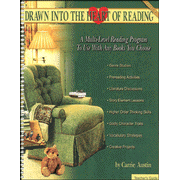Subtitled, “A Multi-Level Reading Program to Use with Any Books You Choose,” Drawn into the Heart of Reading can be used along with your choice of real books for children in grades two through eight. It consists of a teacher’s guide that covers all levels plus student workbooks, available at three levels: grades 2-3, grades 4-5, and grades 6-8. You will also want to purchase the appropriate level of Book Projects to Send Home, small activity books published by McGraw-Hill and available through Heart of Dakota Publishing.
You should start with one of the packages that include the teacher’s guide plus one student book and a Sample Book Ideas list. The Superset includes the teacher’s guide plus all three student books and the Sample Book Ideas list. You may also purchase additional student books individually.
You can use Drawn into the Heart of Reading as a core reading program (assuming young students are already able to read independently) or as a supplement. It is arranged into nine sections, each focused upon a different genre: biography, adventure, historical fiction, fantasy, mystery, folk tales, nonfiction, humor, and realistic fiction. You or your students select books representative of each genre. Because the program is structured for different levels of difficulty you can reuse it for a number of years, even reusing the same level but having your student read different books from each genre.
The program is written for use with groups or individual students; groups can be either your own children working at various levels or same-level groups. Drawn into the Heart of Reading is also a Christian character-building program that incorporates scripture and biblical standards. For most families this means that your entire family will be reading books from the same genre, discussing and comparing similar story elements, and learning about the same character traits.
Some broader language arts skills are covered, and students do a good deal of writing, increasingly so as you move up each level. The guide suggests that young students may dictate some of their lengthier responses rather than writing them themselves. It also suggests writing responses on a whiteboard for students to copy.
The writing assignments themselves actually bring up one point of concern I have with the student workbooks. Workbook pages are formatted for students to fill in boxes, blanks, and circles in response to questions and instructions. However, once in a while the space allowed seems inadequate, especially in the Level 2/3 workbook.
In addition to writing activities, the program incorporates a good deal of discussion, a little drawing, and lots of project ideas. This can be a strong multi-sensory program depending upon which elements you choose to use.
The large, softbound teacher’s guide (with lay-flat binding) features daily lesson plans with specific instructions for work to be done together with students as well as for independent work for each of the three levels. I really appreciate an extra feature found in each student book called “emergency options.” On days when there is no time for the “together” activities, you can turn to emergency options that will fill in with independent-work assignments.
Overall, I really like the flexibility of this sort of reading program that allows parents and children to select their own reading material. The drawback to this approach is that children might be reading books with which parents are unfamiliar. Unless parents have time to also read the books, they might have trouble determining whether or not their children are identifying characters, actions, motives, plot, etc. correctly. Children might narrate to a parent about what they are reading, but a parent’s ability to ask probing questions is limited. The teacher’s guide does direct students in the first two levels to read some portions of their books aloud to parents, which helps somewhat to overcome this potential problem. Another possible strategy is for parents to provide a list of books as options—books with which parents are already familiar. In response to my concern, Carrie Austin told me that “having the parent skim the chapter as the child answers the questions provides accountability and helps give the parent a good idea of whether the child’s answers to the questions are going in the right direction.”
Suggested questions range from simple comprehension to higher-level thinking skills. Thus, children learn to read more thoughtfully and analytically as they work through the “lessons.”
I suspect that after parents and students have worked through a number of books using this program, parents will feel more comfortable allowing children to use unfamiliar books since children will have become accustomed to noticing key information and thinking beyond the surface of the story.









